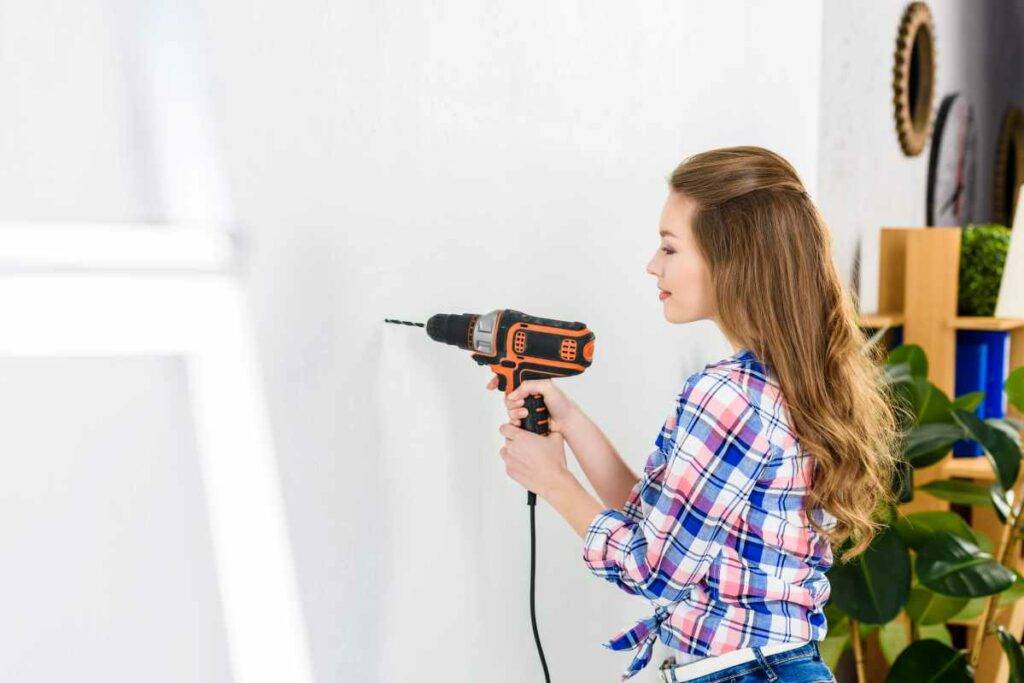Hanging heavy items on a wall, like a shelf or a large picture, requires a solid anchor point to ensure they stay put. That’s where studs come in. Studs are the wooden beams behind your walls that provide structural support, and they’re the best place to anchor heavy objects. But what if you don’t have a stud finder?
Don’t worry, I’ve got you covered. Let me take you through the process of finding studs without a fancy gadget, sharing the challenges I faced and the tips that worked for me.
How to find a stud without a stud finder
Nowadays tools have made our DIY projects easier but knowing how to work without them is necessary as well it makes you independent from relying on a tool. So let’s start with the process.
Why Finding a Stud Matters
When I first started hanging shelves and artwork, I didn’t realize how important it was to find a stud. I thought I could just use wall anchors or screws in drywall, but that led to some wobbly and insecure results. A stud is a solid piece of wood behind your wall, usually 2×4 inches, that gives you the stability you need to support heavy objects. So, if you want your shelves and frames to stay in place, finding a stud is essential.
Understanding Wall Construction
Before we dive into finding studs, it’s helpful to understand a bit about wall construction. Most homes have wood-framed walls with drywall or plaster covering them. Studs are typically spaced 16 inches apart, but in older homes or custom builds, they might be spaced 24 inches apart. Knowing this will help you estimate where to start looking for studs.
Looking for Clues
One of the first things I did was look for clues that might indicate where a stud is located. Here are some of the telltale signs I found:
- Electrical Outlets and Light Switches: These are usually mounted on studs for stability. I checked where the outlets and switches were positioned and used them as a starting point.
- Baseboards and Trim: Sometimes, nails in baseboards or trim can indicate the location of a stud. I looked closely at these areas to see if I could spot any nailheads or bumps.
- Wall Fixtures: If you have existing fixtures on your wall, like curtain rods or wall-mounted TVs, they’re likely attached to studs. I noted their positions and used them as reference points.
Knocking on the Wall
One of the most common methods for finding studs without a stud finder is knocking on the wall and listening for a difference in sound. Here’s how I did it:
- Start at the Corner: I began at the corner of the room and worked my way out, knocking lightly on the wall. A hollow sound usually indicates drywall, while a solid sound suggests a stud.
- Move-in 16-inch Increments: Since studs are typically 16 inches apart, I moved along the wall in those increments, listening for a change in sound.
- Mark the Studs: When I found a spot that sounded solid, I marked it with a pencil. This gave me a reference point to check with other methods.
This technique isn’t foolproof, and it can be challenging if you’re not sure what to listen for. I had to practice a bit to get the hang of it, but once I did, it became easier to identify the subtle differences in sound.
Using a Magnet
Another technique I found helpful was using a magnet to locate screws or nails in the wall, which usually indicate a stud. Here’s how I did it:
- Find a Strong Magnet: I used a small but powerful magnet, the kind you’d find in a hardware store. The stronger the magnet, the better.
- Move the Magnet Along the Wall: I slid the magnet along the wall, paying close attention to when it stuck or pulled toward the wall. This usually happened when I passed over a screw or nail in the drywall.
- Mark the Spots: When the magnet found a spot, I marked it with a pencil. This gave me another clue as to where the studs might be.
Using a magnet was surprisingly effective, but I had to be patient and thorough, especially with thick drywall where screws might be deeply embedded.
Drilling Test Holes
If you’re still unsure about the location of a stud, you can drill small test holes to confirm. This method requires a bit of care to avoid damaging your wall, but it can be quite accurate. Here’s what I did:
- Choose a Small Drill Bit: I used a 1/16-inch drill bit to keep the holes small and easy to patch later.
- Drill Along the Wall: Starting at my marked spots, I drilled small holes to check for resistance. If the bit went through easily, it was likely drywall. If I hit resistance, I knew I was on a stud.
- Use a Level: Once I found a stud, I used a level to determine if it was vertical and to locate additional studs along the same line.
This method was my last resort, as it leaves small holes in the wall, but it’s a reliable way to confirm a stud’s location when other methods are inconclusive. I did encounter some difficulty when the studs weren’t perfectly aligned, which can happen in older homes or after renovations. If the level revealed inconsistency, I adjusted my drilling points to accommodate any deviations in stud placement.
You can also start bedazzling everyone By Picking a Front Door Color
Final Thoughts
Finding a stud without a stud finder can be challenging, but with the right techniques and a bit of patience, you can do it. I found that combining different methods—like knocking on the wall, using a magnet, and drilling test holes—gave me the best results. By following these steps, I was able to securely hang my shelves and artwork without worrying about them coming loose.
One key takeaway is to remain flexible and be prepared to try different methods. Every wall and home is unique, and what works in one situation might not work in another. Don’t be afraid to make small holes or test different areas until you find a solid anchor point.
I hope you found this guide helpful, and I can’t wait to hear about your own stud-finding adventures! If you have any questions or need more tips, I’m always here to help.
What if I Can’t Find a Stud Using These Methods?
If you’re having trouble finding a stud, don’t panic. You can use wall anchors or toggle bolts for lighter items, but be cautious with heavy objects like shelves or large mirrors. If you’re unsure, consider hiring a professional to avoid damage or accidents. Keep in mind that different wall types, such as plaster or double-layered drywall, can make finding studs more difficult.
How Do I Know if I’ve Found a Stud?
A stud will offer resistance when you drill into it, and the sound of knocking will be solid. If you’re still unsure, you can use a nail to probe the area gently. If it goes in only a short distance and feels secure, you’ve likely found a stud. You can also check the depth of the wall and ensure that it’s consistent with stud placement—generally around 4 to 6 inches into the wall.
Can I Use a Magnet to Find Studs in All Walls?
A magnet works well on drywall and plaster walls, but it might be less effective on thicker walls or walls with heavy paint or wallpaper. In such cases, you might need to rely on other methods, like knocking or drilling test holes. Additionally, metal pipes or wiring can sometimes cause false positives, so be sure to verify with other techniques.
Are Studs Always 16 Inches Apart?
In most modern homes, studs are typically 16 inches apart. However, in older homes or custom builds, they could be 24 inches apart or vary in spacing. If you’re unsure, start with the 16-inch increments and adjust based on your findings. You might also find that not every wall has studs at regular intervals, especially if it’s a non-load-bearing wall.
What Should I Do if I Accidentally Damage the Wall While Looking for a Stud?
If you create small holes or scratches while searching for a stud, don’t worry. You can easily repair them with spackle or joint compound. Apply a small amount to the damaged area, smooth it out, and let it dry. Once dry, sand it lightly and touch up with paint to blend it with the rest of the wall. If the damage is more significant, consider seeking professional help to avoid further issues.

